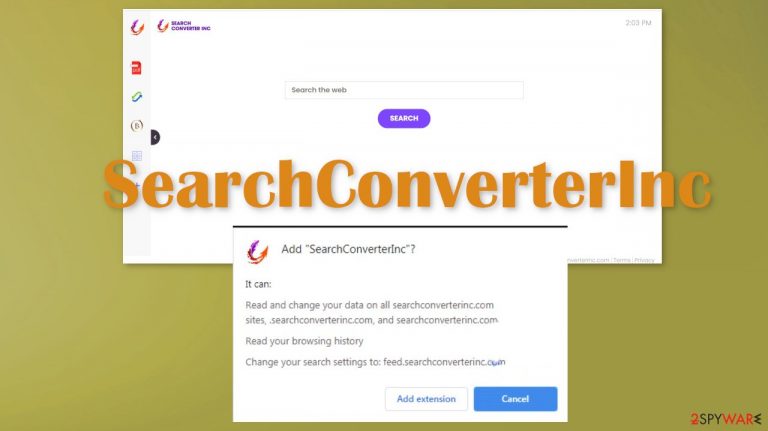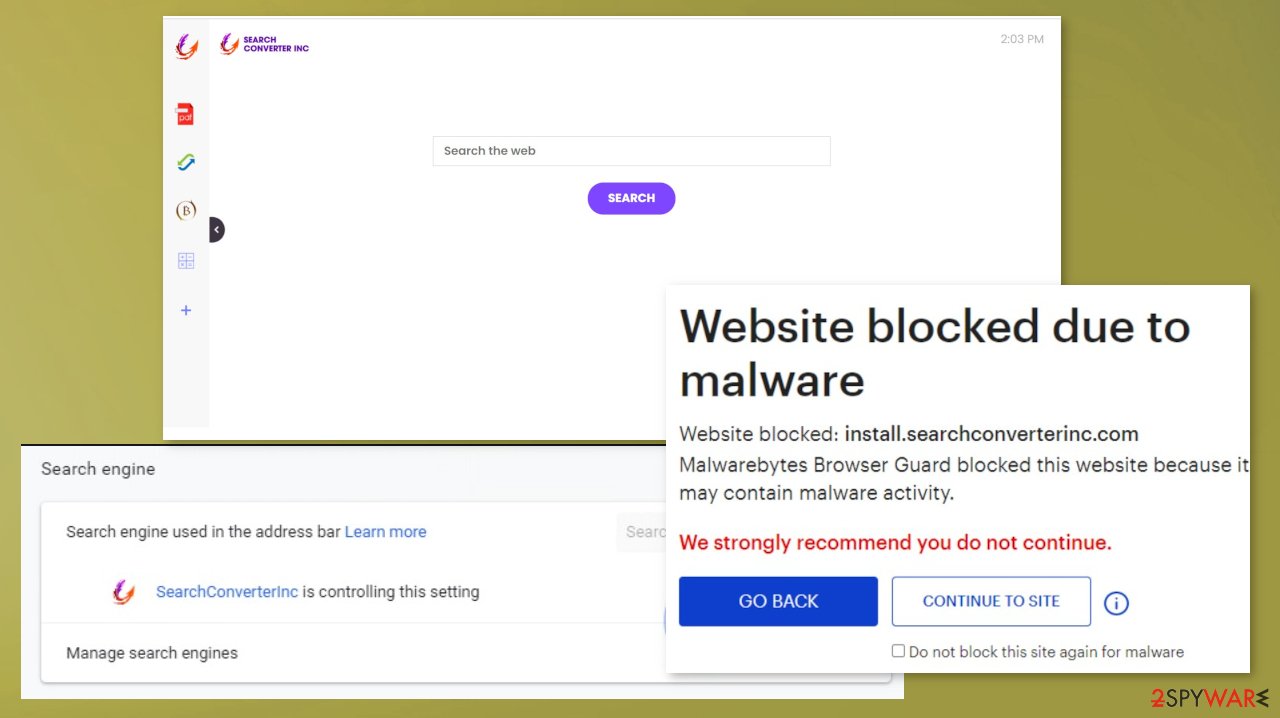SearchConverterInc (Chrome, Firefox, IE, Edge) - 2021 update
SearchConverterInc Removal Guide
What is SearchConverterInc?
SearchConverterInc – a browser hijacker that displays ads as search recommendations

SearchConverterInc is categorized as a browser hijacker due to it making changes to different browser settings, such as the new tab, homepage preferences, and the default search engine preferences. In addition to that, it shows various advertisements camouflaged as search recommendations. If users press the Allow button when asked to enable notifications, whole browser windows might be covered in ads, and sometimes some pop-ups might even appear when the browser is closed.
If you experience any of these symptoms, that means that you installed a shady browser extension on your Google Chrome browser. You might have been redirected from a deceiving ad to Google Web Store, where this potentially unwanted program was offered. Now the said store removed it, but some people are still using this potentially unwanted program[1] (PUP). You can also allow the freeware installation processes to end up in PUP infiltration unknowingly.
People whose homepage and other settings are still redirecting them to portal.searchconverterinc.com, and keep seeing ads on their search results, shouldn't panic. This PUP is quire easily removable, but they shouldn't wait long to do it. People who don't have time for articles can scroll down to the bottom of this one, where our free removal guide is revealed. Although if you want to find out more about this browser hijacker and PUPs – keep on reading.
| name | SearchConverterInc browser hijacker |
|---|---|
| type | Browser hijacker, potentially unwanted program |
| Distribution | Google Chrome Web Store, freeware bundles, deceptive ads, other similar intruders |
| Symptoms | Unwanted extension installed on Chrome browser. Altered browser settings: default search engine, homepage, and new tab preferences. Ads are shown as search recommendations |
| Risks | Installation of other PUPs through deceptive ads. Browsing-related data collection might lead to privacy, financial and identity issues |
| Removal | Manual removal is possible, and we explain how to do that at the bottom of this article. Anti-malware software should be used to make sure no suspicious files were downloaded without your knowledge |
| System Fix | PUP altered system settings can impede normal system performance. Run diagnostics with the FortectIntego app and automatically fix all issues |
If you have browser hijacker installed on your device, it doesn't matter if Google, Yahoo, or Bing, was your default search engine. All search inquires go through searchconverterinc.com, a fake search engine, as it doesn't generate any search results. It redirects people, depending on their geolocation, to legitimate engines.
Usually, browser hijackers are advertised as tools that will increase your online security, privacy, and so on. But in reality, when malware changes all aforementioned settings, it is able to perform these actions:
- Collect browsing data,[2] including geolocations, IP addresses, search inquiries, visited pages, browser, and computer info. This data can be shared with or sold to advertisers and other interested parties
- Show ads as promotions of various commercial websites.
The ads may redirect users to deceptive websites, where additional PUP might get installed. So if you're tired of constantly being redirected to shady sites and want to see normal search results without any ads, it's time to get rid of the unwelcome guest.
We strive to help our readers by any means we can. This time we display free step-by-step instructions on how to remove from Mac and Windows devices. You can find them at the bottom of the article, and make sure to execute them correctly.

Please don't forget to scan your device with a dependable anti-malware tool, such as SpyHunter 5Combo Cleaner or Malwarebytes, when you're finished with manual malware removal. A trustworthy anti-malware tool is a must these days because cyber threats are lurking everywhere.
Once you've removed the browser intruder and scanned for any suspicious files, you should take care of the system files and folders by running a system repair. Experts[3] recommend entrusting this task to the powerful FortectIntego system tune-up tool.
Stealthy and deceptive PUP distribution techniques and how to avoid them
The so-called crapware is on the rise, and it's waiting for inattentive users to install it. There are different ways it can get on a computer. For instance, when visiting shady sites, a pop-up ad might come up telling the user that he/she must update the Adobe Flash player, which will lead to PUP installation.
Our research shows that another popular distribution technique is software bundling. Many online vendors offer to download some software in a pack. If a user is inattentive and chooses Express, Quick, or Recommended installation, all applications within the pack will be installed.

This happens because boxes agreeing to install all software within the bundle are preselected. If you want to evade PUPs, first of all, you've got to stop believing pop-up ads that tell that something is wrong with your device or its software. And when installing apps from bundles, don't forget to choose the Advanced/Custom installation mode. This way, you'll be able to deselect the pre-ticked boxes from apps you didn't intend to install, don't want, don't trust.
Instructions on how to remove browser hijacker from Mac and Windows devices
Potentially unwanted programs, hijackers, adware, are a threat not only to computer users – cell phone users can get their devices infected too. Refrain from using high-risk sites, shady websites, and believe when an ad tells you that's something is wrong with your device.
SearchConverterInc removal process is relatively easy. You don't have to have extensive knowledge to eliminate this browser hijacker. Scroll down, and you'll see our detailed step-by-step instructions for every device. Follow the steps, and you'll uninstall the PUP within minutes.
When you remove malware, run a full system scan with a reliable anti-malware tool to make sure no additional PUPs or malware is hidden somewhere. Afterward, we highly recommend using system repair tools to fix any Registry or any other issues with system-related files and settings.
You may remove virus damage with a help of FortectIntego. SpyHunter 5Combo Cleaner and Malwarebytes are recommended to detect potentially unwanted programs and viruses with all their files and registry entries that are related to them.
Getting rid of SearchConverterInc. Follow these steps
Uninstall from Windows
Instructions for Windows 10/8 machines:
- Enter Control Panel into Windows search box and hit Enter or click on the search result.
- Under Programs, select Uninstall a program.

- From the list, find the entry of the suspicious program.
- Right-click on the application and select Uninstall.
- If User Account Control shows up, click Yes.
- Wait till uninstallation process is complete and click OK.

If you are Windows 7/XP user, proceed with the following instructions:
- Click on Windows Start > Control Panel located on the right pane (if you are Windows XP user, click on Add/Remove Programs).
- In Control Panel, select Programs > Uninstall a program.

- Pick the unwanted application by clicking on it once.
- At the top, click Uninstall/Change.
- In the confirmation prompt, pick Yes.
- Click OK once the removal process is finished.
Delete from macOS
Remove items from Applications folder:
- From the menu bar, select Go > Applications.
- In the Applications folder, look for all related entries.
- Click on the app and drag it to Trash (or right-click and pick Move to Trash)

To fully remove an unwanted app, you need to access Application Support, LaunchAgents, and LaunchDaemons folders and delete relevant files:
- Select Go > Go to Folder.
- Enter /Library/Application Support and click Go or press Enter.
- In the Application Support folder, look for any dubious entries and then delete them.
- Now enter /Library/LaunchAgents and /Library/LaunchDaemons folders the same way and terminate all the related .plist files.

Remove from Microsoft Edge
Delete unwanted extensions from MS Edge:
- Select Menu (three horizontal dots at the top-right of the browser window) and pick Extensions.
- From the list, pick the extension and click on the Gear icon.
- Click on Uninstall at the bottom.

Clear cookies and other browser data:
- Click on the Menu (three horizontal dots at the top-right of the browser window) and select Privacy & security.
- Under Clear browsing data, pick Choose what to clear.
- Select everything (apart from passwords, although you might want to include Media licenses as well, if applicable) and click on Clear.

Restore new tab and homepage settings:
- Click the menu icon and choose Settings.
- Then find On startup section.
- Click Disable if you found any suspicious domain.
Reset MS Edge if the above steps did not work:
- Press on Ctrl + Shift + Esc to open Task Manager.
- Click on More details arrow at the bottom of the window.
- Select Details tab.
- Now scroll down and locate every entry with Microsoft Edge name in it. Right-click on each of them and select End Task to stop MS Edge from running.

If this solution failed to help you, you need to use an advanced Edge reset method. Note that you need to backup your data before proceeding.
- Find the following folder on your computer: C:\\Users\\%username%\\AppData\\Local\\Packages\\Microsoft.MicrosoftEdge_8wekyb3d8bbwe.
- Press Ctrl + A on your keyboard to select all folders.
- Right-click on them and pick Delete

- Now right-click on the Start button and pick Windows PowerShell (Admin).
- When the new window opens, copy and paste the following command, and then press Enter:
Get-AppXPackage -AllUsers -Name Microsoft.MicrosoftEdge | Foreach {Add-AppxPackage -DisableDevelopmentMode -Register “$($_.InstallLocation)\\AppXManifest.xml” -Verbose

Instructions for Chromium-based Edge
Delete extensions from MS Edge (Chromium):
- Open Edge and click select Settings > Extensions.
- Delete unwanted extensions by clicking Remove.

Clear cache and site data:
- Click on Menu and go to Settings.
- Select Privacy, search and services.
- Under Clear browsing data, pick Choose what to clear.
- Under Time range, pick All time.
- Select Clear now.

Reset Chromium-based MS Edge:
- Click on Menu and select Settings.
- On the left side, pick Reset settings.
- Select Restore settings to their default values.
- Confirm with Reset.

Remove from Mozilla Firefox (FF)
Remove dangerous extensions:
- Open Mozilla Firefox browser and click on the Menu (three horizontal lines at the top-right of the window).
- Select Add-ons.
- In here, select unwanted plugin and click Remove.

Reset the homepage:
- Click three horizontal lines at the top right corner to open the menu.
- Choose Options.
- Under Home options, enter your preferred site that will open every time you newly open the Mozilla Firefox.
Clear cookies and site data:
- Click Menu and pick Settings.
- Go to Privacy & Security section.
- Scroll down to locate Cookies and Site Data.
- Click on Clear Data…
- Select Cookies and Site Data, as well as Cached Web Content and press Clear.

Reset Mozilla Firefox
If clearing the browser as explained above did not help, reset Mozilla Firefox:
- Open Mozilla Firefox browser and click the Menu.
- Go to Help and then choose Troubleshooting Information.

- Under Give Firefox a tune up section, click on Refresh Firefox…
- Once the pop-up shows up, confirm the action by pressing on Refresh Firefox.

Remove from Google Chrome
Delete malicious extensions from Google Chrome:
- Open Google Chrome, click on the Menu (three vertical dots at the top-right corner) and select More tools > Extensions.
- In the newly opened window, you will see all the installed extensions. Uninstall all the suspicious plugins that might be related to the unwanted program by clicking Remove.

Clear cache and web data from Chrome:
- Click on Menu and pick Settings.
- Under Privacy and security, select Clear browsing data.
- Select Browsing history, Cookies and other site data, as well as Cached images and files.
- Click Clear data.

Change your homepage:
- Click menu and choose Settings.
- Look for a suspicious site in the On startup section.
- Click on Open a specific or set of pages and click on three dots to find the Remove option.
Reset Google Chrome:
If the previous methods did not help you, reset Google Chrome to eliminate all the unwanted components:
- Click on Menu and select Settings.
- In the Settings, scroll down and click Advanced.
- Scroll down and locate Reset and clean up section.
- Now click Restore settings to their original defaults.
- Confirm with Reset settings.

Delete from Safari
Remove unwanted extensions from Safari:
- Click Safari > Preferences…
- In the new window, pick Extensions.
- Select the unwanted extension and select Uninstall.

Clear cookies and other website data from Safari:
- Click Safari > Clear History…
- From the drop-down menu under Clear, pick all history.
- Confirm with Clear History.

Reset Safari if the above-mentioned steps did not help you:
- Click Safari > Preferences…
- Go to Advanced tab.
- Tick the Show Develop menu in menu bar.
- From the menu bar, click Develop, and then select Empty Caches.

After uninstalling this potentially unwanted program (PUP) and fixing each of your web browsers, we recommend you to scan your PC system with a reputable anti-spyware. This will help you to get rid of SearchConverterInc registry traces and will also identify related parasites or possible malware infections on your computer. For that you can use our top-rated malware remover: FortectIntego, SpyHunter 5Combo Cleaner or Malwarebytes.
How to prevent from getting browser hijacker
Access your website securely from any location
When you work on the domain, site, blog, or different project that requires constant management, content creation, or coding, you may need to connect to the server and content management service more often. The best solution for creating a tighter network could be a dedicated/fixed IP address.
If you make your IP address static and set to your device, you can connect to the CMS from any location and do not create any additional issues for the server or network manager that needs to monitor connections and activities. VPN software providers like Private Internet Access can help you with such settings and offer the option to control the online reputation and manage projects easily from any part of the world.
Recover files after data-affecting malware attacks
While much of the data can be accidentally deleted due to various reasons, malware is one of the main culprits that can cause loss of pictures, documents, videos, and other important files. More serious malware infections lead to significant data loss when your documents, system files, and images get encrypted. In particular, ransomware is is a type of malware that focuses on such functions, so your files become useless without an ability to access them.
Even though there is little to no possibility to recover after file-locking threats, some applications have features for data recovery in the system. In some cases, Data Recovery Pro can also help to recover at least some portion of your data after data-locking virus infection or general cyber infection.
